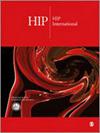原生髋臼前倾角与髋臼横韧带方向的关系
IF 1.1
4区 医学
Q3 ORTHOPEDICS
引用次数: 0
摘要
背景:在全髋关节置换术中,髋臼组件的精确定位是实现最佳植入功能和确保患者长期舒适的关键。然而,不同的解剖变异、退行性病变、发育不良和其他疾病给定位带来了困难。本研究讨论了一种基于横韧带三维方向的方法,该方法能更准确地预测原发性髋臼内翻。方法:使用注册算法从 270 例患者的常规计算机断层扫描数据中自动计算出髋臼的角度位置和横韧带的方向。方法:使用配准算法从 270 名患者的常规计算机断层扫描数据中自动计算出髋臼角度位置和横向韧带方向,并寻找髋臼角度和韧带方向之间的关系以及它们与性别、年龄和骨盆倾斜度之间的关系。结果:将横韧带在矢状平面和横向平面上的方向作为多线性模型中的一个回归因子,可以解释髋臼前倾角的变化(男性 R2 = 0.结论:结果表明,必须考虑韧带在矢状面和横切面上的方向,韧带作为引导结构几乎不敏感。仅根据一个平面的方向进行估计不够准确。手术中髋臼的倾斜度与韧带的方向无关。男性的相关性高于女性。本文章由计算机程序翻译,如有差异,请以英文原文为准。
Relation of native acetabular anteversion to the orientation of transverse acetabular ligament
Background:Precise positioning of the acetabular component during total hip replacement is the key to achieving optimal implant function and ensuring long-term patient comfort. However, different anatomical variations, degenerative changes, dysplasia, and other diseases make it difficult. In this study, we discuss a method based on the three-dimensional direction of the transverse ligament, predicting native acetabular anteversion with higher accuracy.Methods:Angular positions of the acetabulum and direction of the transverse ligament were automatically calculated from routine computed tomography data of 270 patients using a registration algorithm. The relationship between acetabular angles and ligament direction and their relationship with sex, age, and pelvic tilt were sought. These relationships were then modelled using multilinear regression.Results:Including the direction of the transverse ligament in the sagittal and transverse planes as a regressor in the multilinear model explained the variation in acetabular anteversion (R2 = 0.76 for men, R2 = 0.63 for women; standard deviation in prediction: men, 3.92° and women, 4.00°).Conclusions:The results indicate that the ligament was suitable as a guidance structure almost insensitive to the ligament in the sagittal and transverse planes must be considered. Estimation based on the direction in only 1 plane was not sufficiently accurate. The operative acetabular inclination was not correlated with the direction of the ligament. The correlations were higher in men than in women.
求助全文
通过发布文献求助,成功后即可免费获取论文全文。
去求助
来源期刊

HIP International
医学-整形外科
CiteScore
4.20
自引率
0.00%
发文量
70
审稿时长
2 months
期刊介绍:
HIP International is the official journal of the European Hip Society. It is the only international, peer-reviewed, bi-monthly journal dedicated to diseases of the hip. HIP International considers contributions relating to hip surgery, traumatology of the hip, prosthetic surgery, biomechanics, and basic sciences relating to the hip. HIP International invites reviews from leading specialists with the aim of informing its readers of current evidence-based best practice.
The journal also publishes supplements containing proceedings of symposia, special meetings or articles of special educational merit.
HIP International is divided into six independent sections led by editors of the highest scientific merit. These sections are:
• Biomaterials
• Biomechanics
• Conservative Hip Surgery
• Paediatrics
• Primary and Revision Hip Arthroplasty
• Traumatology
 求助内容:
求助内容: 应助结果提醒方式:
应助结果提醒方式:


